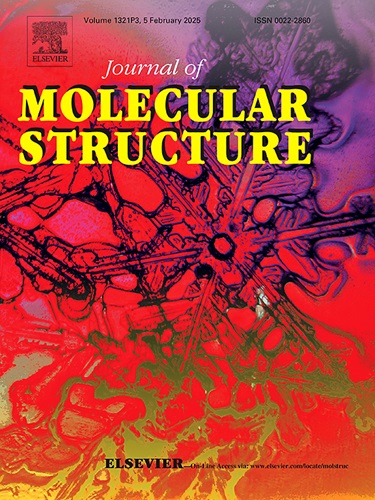高效Ba/ ti掺杂g-C3N4纳米吸附剂改善吸附和选择性除铅
IF 4
2区 化学
Q2 CHEMISTRY, PHYSICAL
引用次数: 0
摘要
本文采用溶胶-凝胶法在层状g-C3N4片上合成了一种先进的Ba-TiO2纳米颗粒复合材料,并利用扫描电镜、透射电镜、x射线衍射、傅里叶变换红外光谱、x射线光电子显微镜对其进行了表征。由于其大表面积(≈99 m2/g),对Pb+2表现出较高的吸附能力,最高可达450 mg /g,吸附动力学符合拟二级模型,Langmuir和Freundlich等温线很好地描述了吸附平衡。该复合材料对Cu+2、Zn+2、Ni+2、Co+2和Cd+2离子具有较高的吸附选择性,并具有5轮再生和可回收性。假设阳离子−π相互作用、孔扩散、-NH2和-OH键是Pb+2离子吸附的机制。这些发现验证了Ba-TiO2纳米颗粒/ g-C3N4 (BaTiCN)复合材料是一种潜在的清除水中重金属的复合材料。本文章由计算机程序翻译,如有差异,请以英文原文为准。

Efficient Ba/Ti-doped g-C3N4 nanosorbent for improved adsorption and selective lead abolition
Herein, an advanced composite consisting of Ba-TiO2 nanoparticles grown on layered g-C3N4 sheets was synthesized through a facile sol-gel-based Pechini method and characterized using scanning and transmission electron microscopy, X-ray Diffraction, Fourier-transformed infrared spectroscopy, X-ray photoelectron microscopy. Due to its large surface area (≈99 m2/g), the composite exhibited high adsorption ability towards Pb+2 reaching up to 450 mg / g where the adsorption kinetics complied with the pseudo-second-order model and the Langmuir and Freundlich isotherms well described the adsorption equilibrium. The composite exhibited high selectivity for the Pb+2 adsorption over the Cu+2, Zn+2, Ni+2, Co+2, and Cd+2 ions along with five rounds of regeneration and recyclability. Cation−π interaction, pore diffusion, –NH2, and –OH bonding was postulated as a mechanism for the Pb+2 ions adsorption. These findings validated that the Ba-TiO2 nanoparticles/ g-C3N4 (BaTiCN) composite was a potential composite for the scavenging of heavy metals in water systems.
求助全文
通过发布文献求助,成功后即可免费获取论文全文。
去求助
来源期刊

Journal of Molecular Structure
化学-物理化学
CiteScore
7.10
自引率
15.80%
发文量
2384
审稿时长
45 days
期刊介绍:
The Journal of Molecular Structure is dedicated to the publication of full-length articles and review papers, providing important new structural information on all types of chemical species including:
• Stable and unstable molecules in all types of environments (vapour, molecular beam, liquid, solution, liquid crystal, solid state, matrix-isolated, surface-absorbed etc.)
• Chemical intermediates
• Molecules in excited states
• Biological molecules
• Polymers.
The methods used may include any combination of spectroscopic and non-spectroscopic techniques, for example:
• Infrared spectroscopy (mid, far, near)
• Raman spectroscopy and non-linear Raman methods (CARS, etc.)
• Electronic absorption spectroscopy
• Optical rotatory dispersion and circular dichroism
• Fluorescence and phosphorescence techniques
• Electron spectroscopies (PES, XPS), EXAFS, etc.
• Microwave spectroscopy
• Electron diffraction
• NMR and ESR spectroscopies
• Mössbauer spectroscopy
• X-ray crystallography
• Charge Density Analyses
• Computational Studies (supplementing experimental methods)
We encourage publications combining theoretical and experimental approaches. The structural insights gained by the studies should be correlated with the properties, activity and/ or reactivity of the molecule under investigation and the relevance of this molecule and its implications should be discussed.
 求助内容:
求助内容: 应助结果提醒方式:
应助结果提醒方式:


